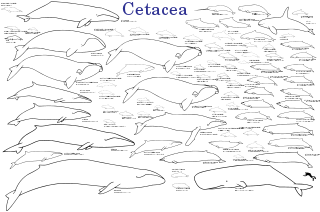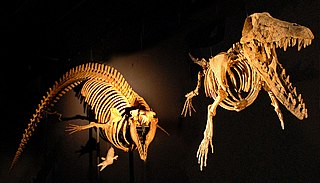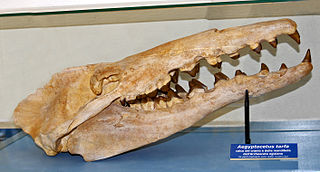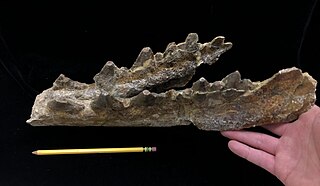
Rodhocetus is an extinct genus of protocetid early whale known from the Lutetian of Pakistan. The best-known protocetid, Rodhocetus is known from two partial skeletons that taken together give a complete image of an Eocene whale that had short limbs with long hands and feet that were probably webbed and a sacrum that was immobile with four partially fused sacral vertebrae. It is one of several extinct whale genera that possess land mammal characteristics, thus demonstrating the evolutionary transition from land to sea.

The evolution of cetaceans is thought to have begun in the Indian subcontinent from even-toed ungulates (Artiodactyla) 50 million years ago (mya) and to have proceeded over a period of at least 15 million years. Cetaceans are fully aquatic mammals belonging to the order Artiodactyla and branched off from other artiodactyls around 50 mya. Cetaceans are thought to have evolved during the Eocene, the second epoch of the present-extending Cenozoic Era. Molecular and morphological analyses suggest Cetacea share a relatively recent closest common ancestor with hippopotami and that they are sister groups. Being mammals, they surface to breathe air; they have five finger bones (even-toed) in their fins; they nurse their young; and, despite their fully aquatic life style, they retain many skeletal features from their terrestrial ancestors. Research conducted in the late 1970s in Pakistan revealed several stages in the transition of cetaceans from land to sea.

Archaeoceti, or Zeuglodontes in older literature, is a paraphyletic group of primitive cetaceans that lived from the Early Eocene to the late Oligocene. Representing the earliest cetacean radiation, they include the initial amphibious stages in cetacean evolution, thus are the ancestors of both modern cetacean suborders, Mysticeti and Odontoceti. This initial diversification occurred in the shallow waters that separated India and Asia 53 to 45 mya, resulting in some 30 species adapted to a fully oceanic life. Echolocation and filter-feeding evolved during a second radiation 36 to 35 mya.
Himalayacetus is an extinct genus of carnivorous aquatic mammal of the family Ambulocetidae. The holotype was found in Himachal Pradesh, India, in what was the remnants of the ancient Tethys Ocean during the Early Eocene. This makes Himalayacetus the oldest archaeocete known, extending the fossil record of whales some 3.5 million years.

Remingtonocetus is an extinct genus of early cetacean freshwater aquatic mammals of the family Remingtonocetidae endemic to the coastline of the ancient Tethys Ocean during the Eocene. It was named after naturalist Remington Kellogg.

Georgiacetus is an extinct genus of ancient whale known from the Eocene period of the United States. Fossils are known from Georgia, Alabama, and Mississippi and protocetid fossils from the right time frame, but not yet confirmed as Georgiacetus, have been found in Texas and South Carolina.

Remingtonocetidae is a diverse family of early aquatic mammals of the order Cetacea. The family is named after paleocetologist Remington Kellogg.

Chrysocetus is a genus of extinct early whale known from Late Eocene-aged fossils of the eastern United States and western Africa. It is the second smallest basilosaurid after Saghacetus.

Aegyptocetus is an extinct genus of protocetid archaeocete whale known from Egypt.
Babiacetus is an extinct genus of early cetacean that lived during the late Lutetian middle Eocene of India . It was named after its type locality, the Harudi Formation in the Babia Hills, Kutch District, Gujarat, India.

Pappocetus is an extinct protocetid cetacean known from the Eocene of southern Nigeria's Ameki Formation and Togo. More recently, fossil teeth and femurs have also been discovered in the Aridal Formation of the Sahara Desert in southwestern Morocco.
Natchitochia is an extinct protocetid early whale known from the Middle Eocene Cook Mountain Formation in Natchitoches Parish, Louisiana.

Qaisracetus is an extinct protocetid early whale known from the Eocene of Baluchistan, Pakistan.
Carolinacetus is an extinct protocetid early whale found in the Bartonian Tupelo Bay Formation in Berkeley County, South Carolina.

Indocetus is a protocetid early whale known from the late early Eocene Harudi Formation in Kutch, India.
Eocetus is an extinct protocetid early whale known from the early-late Eocene Giushi Formation in Gebel Mokattam, outside Cairo, Egypt. Fossil remains have also been discovered in the Aridal Formation of the Sahara Desert in southwestern Morocco.
The Belgrade Formation is a limestone geologic formation in North Carolina characterized by limestone coquina mixed with sand, and thinly laminated clays. It preserves fossils dating back to the Paleogene period.
The Piney Point Formation is a geologic formation in Virginia. It preserves fossils dating back to the Lutetian Stage of the Eocene Epoch of the Paleogene period.

Kharodacetus is a genus of protocetid cetacean from the middle Eocene of Kutch, Gujarat, southwestern India.
Tupelocetus is an extinct genus of early cetacean found in the Bartonian Middle Eocene Tupelo Bay Formation, in Berkeley County, South Carolina.










